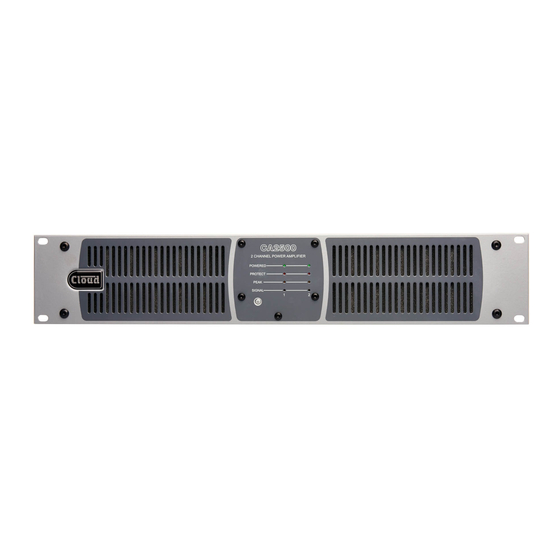- ページ 2
コントロールユニット Cloud CV SERIESのPDF マニュアルをオンラインで閲覧またはダウンロードできます。Cloud CV SERIES 15 ページ。
Cloud CV SERIES にも: テクニカル・ニュース (13 ページ)

input routing, which may be done using rear panel DIP switches.
Where more advanced configuration options are needed, they can
be easily accessed through the internal web server and an Ethernet
connection to an external device.
Models:
The range comprises three models:
MODEL
CHANNELS
CV2500
2
CV4250
4
CV8125
8
The amplifiers use an energy-efficient Class D output stage which
dispenses with line output transformers, and consequently offer
great savings in weight and size over traditional designs of equivalent
power ratings. Safety features of the design include output DC
detection, overcurrent protection, and thermal monitoring. A
switch-on delay provides loudspeaker protection at power-up. All
models are built in a 2U steel enclosure, and use variable–speed
forced-air cooling.
All models have a total power output capability of 1 kW, this
maximum power rating being shared equally between odd-numbered
channels in any combination, and even-numbered channels in any
combination. Thus the odd-numbered channels can deliver a total
of 500 W and similarly, the even-numbered channels can deliver
500 W. This feature allows – for example – one multi-channel
amplifier to drive loudspeaker systems in areas of a building differing
in size, while optimising the overall power capability.
Particular design attention has been paid to the amplifiers' energy
efficiency*. An automatic power-down (APD) feature puts the
amplifier into an ultra-low-current standby mode if no input
signal has been detected for 30 minutes; in this mode the power
consumption is approx. 2.5 W. The amplifiers also include a remote
standby/wake up function, enabling them to be placed into standby
mode - and subsequently powered-up again - by a simple external
contact closure. Wake-up time is typically 200 ms.
In addition to the "soft" power switch and associated LED, the front
panels are fitted with four LEDs for each channel: these confirm
signal presence, peak level, activation of the protection circuitry and
amplifier power status.
*ENERGY STAR certification.
The inputs are electronically balanced, on plug-in multiway
connectors. Rear panel controls are provided for individual channel
levels; multi-pole DIP switches allow the configuration of input
routing options and the selection of per-channel 65 Hz high-pass
filters (to help prevent loudspeaker transformer core saturation
in 70/100 V-line systems). Further DIP switches allow selection
of 70 V-line or 100 V-line working. The rear panel also provides
two balanced, line level, auxiliary outputs which may be used to
feed low-frequency subs, additional amplifiers, for recording, or
POWER
other purposes. By default, these carry the "pre-amp out" signals
2 x 500 W
in Channels 1 and 2 respectively, but either may be extensively
reconfigured via software (see following pages).
4 x 250 W
8 x 125 W
Many more set-up options can be achieved by configuring the
amplifier's DSP section, which uses an on-board web server. This may
be accessed via the Ethernet interface from any computer or other
device with an HTML5/CSS3-compatible browser application. DSP
functions include input routing, level, limiting, 7-band Room EQ,
hi-pass filtering, up to 1.5 s of delay and 5-band speaker optimisation
EQ. Total flexibility of input routing permits an amplifier to be easily
configured for multi-channel or parallel channel operation, biamping
with full control of crossover parameters, or derivation of a separate
channel for sub-bass use (model dependent). Additionally, it is also
possible to redefine the sources for the auxiliary outputs, which
also include Room and Speaker EQ sections, crossover filtering and
level controls. Users can determine which amplifier functions are
accessible on the hardware controls and which are only available via
the web browser interface, and there is also a password protected,
multi-user security system to define the accessibility to the various
unit functions for different users.
In addition to Ethernet remote control via the web server pages,
the amplifiers are compatible with standard Cloud RL Series remote
level control plates: each channel has a dedicated remote control
connector for this purpose. A greater degree of control is possible via
the RS-232C serial port; this allows the amplifier's levels, channel
mutes and power-down to be readily controlled by most third-party
control systems (e.g., Crestron, AMX, etc.). Serial codes may also
be transmitted via Ethernet. A 3-way GPIO port is also provided,
which may be used as an external master mute (equivalent to the
Music Mute control input on most other Cloud products), or for fault
condition signalisation.
An optional web monitor card, the WM-n is available for all models
(where 'n' = the number of channels supported); this replaces the
standard speaker output card and performs scheduled, offline
impedance tests using test tones.
Internal temperatures, amplifier power status and results of
impedance tests (when the optional WM-n card is fitted) will be
reported via the web interface and SNMP.
C l e a r l y b e t t e r s o u n d
